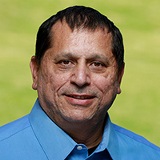
2021 MRS Fall Meeting
Our new hybrid format offered the strong, robust scientific forum MRS Meeting attendees have enjoyed in the past, while making sure the content was accessible to the greater materials research community. The meeting showcased breakthrough materials research in both fundamental and applied areas.
Networking events, professional development opportunities and a lively exhibit of international manufacturers, suppliers and developers rounded out the enriching meeting experience that will shape the future of materials research.
Symposium Topics
EN01—Materials for Sustainable Electronics
EN02—Solid-State Batteries—Electrodes, Electrolytes and Interphases
EN04—Silicon for Photovoltaics
EN05—Emerging Energy and Materials Sciences in Halide Perovskites
EN06—Sustainable Electronics—Green Chemistry, Circular Materials, End-of-Life and Eco-Design
EN07—Mechano-Thermal and Electrical Coupling in Emerging Energy Materials
EN08—Low-Dimensional Halide Perovskites—From Fundamentals to Applications
EN09—Metal Sulfides for High Performance Electrochemical Batteries
EN10—Advanced Materials for Thermal Energy Management and Harvesting
EN12—Advanced Materials and Chemistries for Low-Cost and Sustainable Batteries
EN13—Climate Change Mitigation Technologies
EN14—Advanced Materials for Hydrogen and Fuel Cell Technologies
EN15—Materials Research Opportunities for Energy Efficient Computing
EQ01—Quantum Optical Materials and Devices Based on Impurity Systems
EQ02—Heterostructures of Various Dimensional Materials
EQ03—Spin-Based Sensing at the Nanoscale and Hyperpolarization with NV-Diamond and Beyond
EQ04—Machine Learning on Experimental Data for Emergent Quantum Materials
EQ05—Plasmonics, Nanophotonics and Metaphotonics—Design, Materials and Applications
EQ06—Innovative Fabrication and Processing Methods for Organic and Hybrid Electronics
EQ07—Defects and Strain Potential Enabled Emergent Behavior in Two-Dimensional Materials
EQ08—New Frontiers in the Design, Fabrication and Applications of Metamaterials and Metasurfaces
EQ09—Cutting-Edge Plasma Processes for Next-Generation Materials Science Applications
EQ10—Multiferroics and Magnetoelectrics
EQ12—Optical Probes of Nanostructured, Organic and Hybrid Materials
EQ13—Nitride Materials—Synthesis, Characterization and Modeling
EQ14—Materials and Devices for Controlling Quantum-Coherent Spin Dynamics
EQ15—Soft Matter Materials and Mechanics for Haptic Interfaces
EQ16—Infrared and Thermal Photonic Materials and Their Applications
EQ17—Emerging Materials for Contacts and Interfaces in Optoelectronics
EQ18—Emerging Materials for Quantum Information
EQ19—Diamond and Diamond Heterojunctions—From Growth to Applications
EQ20—Beyond Graphene 2D Materials—Synthesis, Properties and Device Applications
SB01—Engineered Functional Multicellular Circuits, Devices and Systems
SB02—From Hydrogel Fundamentals to Novel Applications via Additive Manufacturing
SB03—Transformative Nanostructures with Therapeutic and Diagnostic Modalities
SB05—Antimicrobial Materials Against Coronaviruses and Other Nosocomial Pathogens
SB06—Graphene and Related 2D Materials for Bioelectronics and Healthcare
SB07—Soft, Healable Materials and Devices for Biological Interfaces and Wearables
SB08—Bioelectronics—Materials and Interfaces
SB09—Biological and Bioinspired Functional Materials—From Nature to Applications
SB11—Photo/Electrical Phenomena at the Interface with Living Cells and Bacteria
SF01—Advanced Atomic Layer Deposition and Chemical Vapor Deposition Techniques and Applications
SF02—Additive Manufacturing—From Material Design to Emerging Applications
SF03—3D Printing of Functional Materials and Devices
SF04—New Types of Polymers, Composites and Hybrid Materials for Additive Manufacturing
Meeting Chairs
-

Massachusetts Institute of Technology
-

Cornell University
-

University of California, Davis
-

Universität Stuttgart
-

University of California, Riverside
Stay Connected to MRS Journals!


